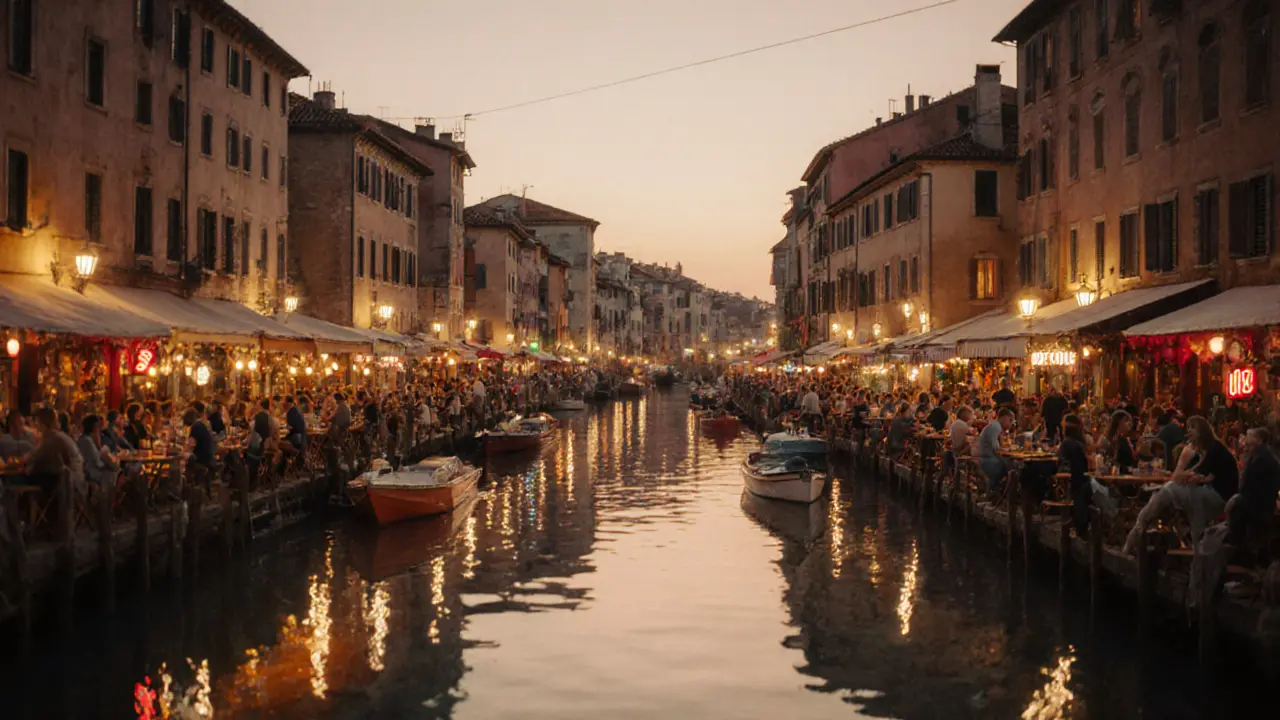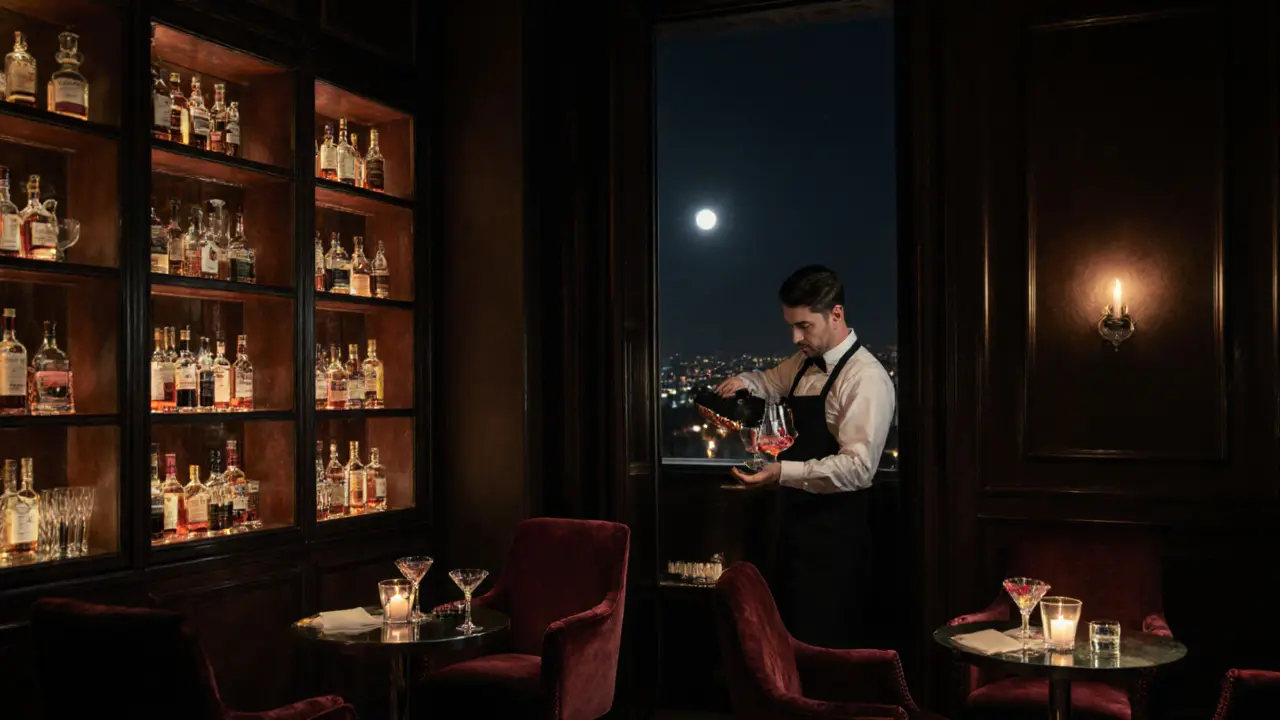Nightlife in Milan: Best Clubs, Bars, and Lounges for 2025
 Nov, 20 2025
Nov, 20 2025
Milan doesn’t sleep. Even at 3 a.m., the streets around Brera and Navigli hum with laughter, basslines, and clinking glasses. This isn’t just a city that knows how to dress well-it knows how to party harder than most European capitals. Forget the old idea that Italians only drink wine at dinner. Milan’s nightlife is a full-blown, high-energy, fashion-forward experience that starts late and ends even later.
Where the Night Begins: Navigli District
Start your night in Navigli. This canal-lined neighborhood used to be a quiet corner for artists and locals. Now, it’s the heart of Milan’s casual nightlife. The canals are lined with open-air bars where you can sip an Aperol Spritz while watching boats drift by. It’s the perfect place to ease into the evening without the pressure of a dress code.
Bar Basso, where the Negroni was invented in 1919, still serves the original recipe-bitter, sweet, strong. Don’t skip it. Nearby, La Baita is a local favorite with live jazz on weekends and a backyard garden that turns into a dance floor when the sun goes down. Most spots here don’t charge cover before midnight, and drinks stay under €10. If you want to feel like a Milanese, skip the tourist traps near the main bridge and walk a few blocks inland.
Clubbing Like a Pro: The Big Names
If you’re here for clubs, you’ve got two choices: go big or go underground. For the former, La Scala is the answer. Not the opera house-the club. Opened in 2023, it’s the most talked-about venue in the city. Think minimalist design, sound engineered by Italian audio specialists, and a lineup that brings in DJs from Berlin, London, and Tokyo. Entry is €25 after 1 a.m., and the crowd? Fashion models, tech founders, and international art curators. No hoodies. No sneakers. Dress sharp or stay out.
For something more raw, head to Capo Corte in the Porta Venezia area. It’s a converted warehouse with no sign, no website, and a door that only opens if the bouncer likes your vibe. The music? Deep house, techno, and experimental beats. No VIP tables. No bottle service. Just a dark room, a killer sound system, and a crowd that’s there for the music, not the Instagram shot. Doors open at 1 a.m., and it’s packed by 2.
Lounges That Feel Like Private Parties
Not every night needs a crowd. If you want to sip something rare, talk with someone interesting, and maybe even meet a local designer or filmmaker, head to a lounge. Bar Basso is great for cocktails, but for atmosphere, try Il Salotto di Via Manzoni. It’s hidden behind a bookshelf in a 19th-century palazzo. Only 20 seats. Reservations required. The bartender knows your name by the second drink.
Another gem: La Bussola on Via Torino. It’s a rooftop lounge with a view of the Duomo, velvet couches, and a curated playlist of Italian indie rock and 70s soul. They serve small plates-truffle arancini, aged bresaola, local cheeses. It’s not cheap (cocktails start at €18), but it’s the kind of place you remember for years. Go on a Thursday or Friday. Weekends get too loud.

Hidden Gems and Local Secrets
Most tourists never find these spots. But locals know them by heart.
- Bar Boffa in Brera-open since 1934. No menu. Just ask for the ‘special’ and the bartender will make you something based on your mood.
- Bar Luce inside the Fondazione Prada. Designed by Wes Anderson, it’s a 1950s Italian café with mint-green walls and espresso served in tiny cups. It’s free to enter, but you can’t stay past 11 p.m.
- Stazione di Passante-a club inside a disused train station near Porta Genova. The walls are covered in graffiti, the floor is concrete, and the DJs play rare vinyl from the 90s. It’s open only on the last Saturday of every month. No announcements. You hear about it from someone who was there last time.
What to Wear (And What Not To)
Milan doesn’t care if you’re rich. It cares if you care. You don’t need designer labels, but you do need to look intentional.
For clubs like La Scala or Capo Corte: dark jeans, clean sneakers or boots, a tailored jacket or a stylish knit. No baseball caps. No flip-flops. No oversized hoodies. Even in winter, locals wear layers that look deliberate-not like they grabbed the first thing off the floor.
For lounges and bars: think ‘elegant casual.’ A button-down shirt, a nice sweater, or a midi dress. No athletic wear. No beachwear. Even if it’s raining, you’ll see people walking from Navigli to La Scala in raincoats that look like they came from a boutique.
If you’re unsure, ask yourself: ‘Would I wear this to a gallery opening?’ If the answer is no, change it.

When to Go and How to Avoid the Crowds
Friday and Saturday nights are packed. If you want a better experience, go midweek.
- Wednesday is the best night for underground clubs. Capo Corte and Stazione di Passante are quieter, the DJs play longer sets, and the vibe is more relaxed.
- Thursday is when the lounges come alive. La Bussola and Il Salotto have live acoustic sets and fewer tourists.
- Monday is for late-night breakfasts. Bars like Bar Basso serve espresso and cornetti until 4 a.m. Locals call it ‘il caffè del risveglio’-the coffee that wakes you up after the party.
Also, avoid the areas around Piazza del Duomo after 10 p.m. The clubs there are overpriced, the music is generic, and the crowd is mostly tourists waiting for a photo op. Walk 15 minutes to Navigli or Brera instead.
Drinks to Try
You’re in Italy. Drink like it.
- Aperol Spritz-the classic. Order it with Prosecco, Aperol, soda. Not too sweet, not too bitter.
- Negroni-stronger, bolder. Bar Basso’s version is still the gold standard.
- Amaretto Sour-a Milan specialty. Made with local amaretto, lemon, and egg white. Creamy, sweet, with a kick.
- Wine by the glass-ask for ‘vino della casa’ or ‘vino locale.’ Many bars pour small-batch wines from Lombardy. You’ll pay €6-€8 for a glass that costs €25 in New York.
Don’t order a Mojito or a Long Island Iced Tea. No one does. And if you do, you’ll get a look.
Final Tips for a Great Night
- Start late. Most places don’t fill up until after midnight. Show up at 11 p.m. and you’ll be the first one there.
- Bring cash. Many small clubs and bars don’t take cards, especially after 2 a.m.
- Know your limits. Milanese nightlife isn’t about getting drunk-it’s about savoring the moment. Pace yourself.
- Ask for advice. Bartenders and club staff are usually locals. They’ll point you to the real spots.
- Don’t rush. One great night in Milan beats five rushed ones. Sit. Talk. Listen to the music. Let the city move around you.
Milan’s nightlife isn’t about flashing money or checking off venues. It’s about feeling the rhythm of the city after dark-the way the lights reflect off the canals, how the bass vibrates through the floor of a warehouse club, the quiet hum of conversation in a dimly lit lounge. It’s not just partying. It’s living.
What time do clubs in Milan usually open and close?
Most clubs in Milan open around midnight and stay open until 4 a.m. or later. Popular spots like La Scala and Capo Corte often let people stay until 5 a.m. on weekends. Bars in Navigli and Brera stay open until 3 a.m. or later, and some, like Bar Basso, serve drinks until 4 a.m. on weekends.
Is there a dress code for Milan nightclubs?
Yes, especially at upscale clubs like La Scala. No sneakers, no hoodies, no shorts. Dark jeans, clean shoes, and a stylish top or jacket are the standard. Lounges are more relaxed but still expect neat, intentional outfits. If you’re unsure, think ‘elegant casual’-nothing flashy, but nothing sloppy either.
Are Milan nightclubs safe for tourists?
Generally, yes. Milan is one of the safest major cities in Italy for nightlife. Stick to well-known areas like Navigli, Brera, and Porta Venezia. Avoid poorly lit alleys after 2 a.m. Most clubs have security, and bouncers are usually helpful. As always, keep your valuables close and avoid flashing expensive gear.
How much should I budget for a night out in Milan?
You can have a great night for €30-€50. Drinks at bars cost €8-€12, club entry is €15-€25, and food at lounges runs €10-€20. Skip the tourist traps near the Duomo-they charge double. Stick to Navigli, Brera, and Porta Venezia for better value and better vibes.
Can I go to Milan clubs if I don’t speak Italian?
Absolutely. Most club staff and bartenders speak English, especially in tourist-heavy areas. You won’t need Italian to get in, order a drink, or find your way. But learning a few phrases-like ‘Un Aperol Spritz, per favore’-goes a long way. Locals appreciate the effort.
What’s the best night of the week for nightlife in Milan?
Thursday and Wednesday are the best for authentic experiences. Thursday has the best lounges and live music; Wednesday is when the underground clubs are most alive and least crowded. Friday and Saturday are packed with tourists and locals alike, so if you want space, quiet, and better DJs, skip the weekend.
